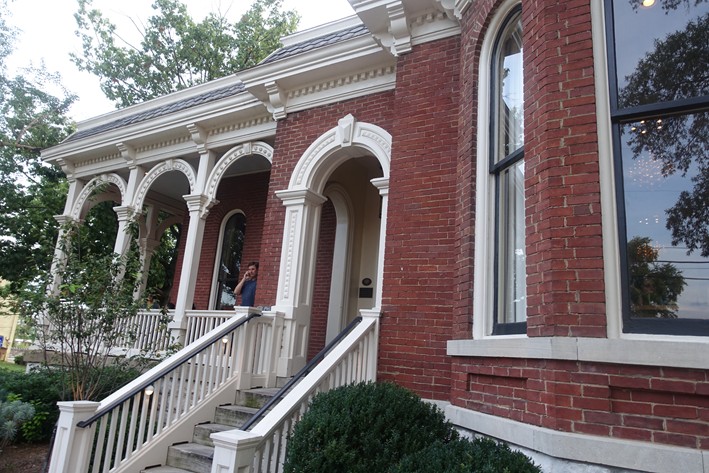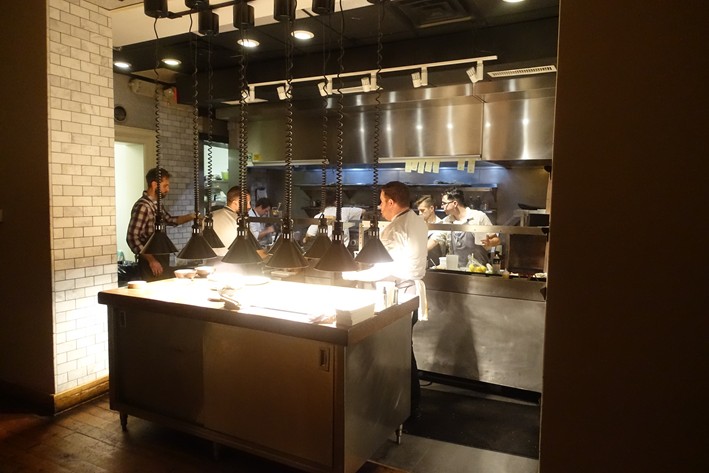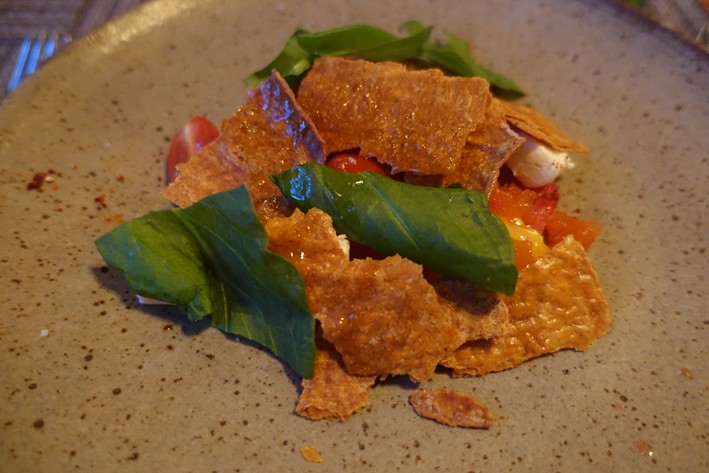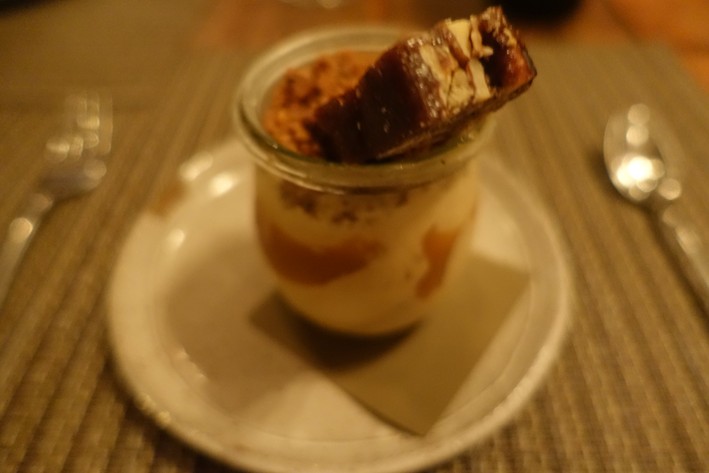Husk in Nashville has been open since 2013, the younger sister of Husk in Charleston, which opened in 2010 and where chef/owner Sean Brock has built up a national reputation based on his championing of traditional southern US cuisine. He splits his time between the two locations, and I think I spotted him in the kitchen tonight. Mr Brock trained for two years at the Peninsula Grill in Charleston, then became executive sous chef at Lemaire Restaurant at the Jefferson Hotel in Richmond. He then was executive chef at the Hermitage Hotel in Nashville, staying for three years before returning to Charleston as executive chef at McCrady’s Restaurant. Here he started a farm on Wadmalaw Island specialising in rare heirloom crops, such as James Island Red Corn, from which he makes grits.
The Nashville Husk is set in an attractive 19th century house on a hill overlooking the city. There is a porch with seating, which comes in handy since the restaurant seems to struggle to process its customers in line with its reservation times. We were dining at 18:45 on a Sunday, and waited almost half an hour before we were seated at our table. There were plenty of other people milling around waiting when we arrived, and even more by the time that we left.
The dining area is split into a few different rooms, and is quite attractive, with high ceilings and wooden floors, though the lighting is distinctly murky. The hard surfaces contribute to quite high noise levels - my app recorded 110 Db at peak, and rarely dipped below 100 Db, meaning that even speaking to your dining companion directly next to you requires a raised voice. The menu offers a la carte rather than a tasting menu, “with no substitutions”. The wine list was quite short and was organised, unusually, by soil type rather than country or style, so you see wines with groupings like “alluvial” and “limestone”. It ranged in price from $40 to $99, with sample labels being The Furst Riesling 2014from Alsace at $40 for a bottle that can be found in the high street for $14, the very enjoyable Kruger-Rumpf Musterer Dautenplanzer Spatlese 2015 at $69 compared to its retail price of $34, and Patricia Green Cellars Volcanic Pinot Noir 2014 at $99 for a bottle that will set you back $43 in a shop.
There were no nibbles, but there was bread, a soft white roll made by a local bakery called Bobby John Henry. This had pleasant texture and was enjoyable (14/20). Fuskie crab rice had a layer of tomato jam, on top of which was rice with chives, then a layer of sautéed crab, celery and crumbled bacon, garnished with crab roe. This was not pretty to look at but had reasonably good flavour, the bacon subtle to the point of invisibility but the rice having good texture (13/20). This was better than heritage tomatoes with goat cheese, sorrel and biscuit crackers. Such a simple dish lives or dies by the quality of the tomatoes, and these were distinctly ordinary, rather watery and not having much flavour. The crackers were fine, as was the goat cheese, but this never went beyond ordinary (11/20).
For the main course, chicken came with a slab of butternut squash and buttermilk with sunflower. The chicken itself, from a supplier called Springer Mountain Farms in the Blue Ridge Mountains, had decent flavour but the meat was dried out around the edges. The slab of squash and buttermilk was harmless enough but did not taste of much. Seasoning of the dish was also underpowered (12/20 would be kind). Catfish was grilled and served with borage, courgettes and rice grits. The rice used, Carolina gold, is a long grained, fragile rice. The “grits” term is due to the rice used being broken grains that have a creamy texture when cooked, though the name is rather odd as the texture is smooth rather than gritty. These bear no relation to traditional grits, which are made from corn husk kernels, which can indeed be gritty in texture if not made well. This was another dish that was not going to win any awards for presentation, but the catfish was cooked properly and the rice was duly creamy, the courgettes on the side under-seasoned but cooked all right (12/20). Catfish has a mild flavour and can be found in some unscrupulous UK fish and chip shops labelled as cod.
For dessert, a peach pie looked like something you would find on the shelves of a cheap cake shop, but tasted fine, with decent if slightly hard pastry and quite nice peach flavour (13/20). This was better than “brown butter soft serve”, which was barbecued caramel, smoked cocoa nib and “embered pecan forte’, the latter having spent too much time amongst the embers judging by its distinctly burnt taste (11/20), Coffee was “just regular, no espresso or latte”, from a local company called Crema, and was fairly ordinary but drinkable.
Service was excellent, from a waiter who knew the menu well and topped up our wine faultlessly. The bill came to $122 (£95) a head before tip. If you shared a modest bottle of wine, had coffee and topped well then a typical spend might be $95 (£74). This seemed like a lot of money for the standard of food that we ate tonight. I like the idea of serving the cuisine of the US south, but I was hoping for something a lot better than this given the assorted awards that the Husk restaurants have won. In was not, for example, in the same league as Elizebeth’s in Savannah. Despite my misgivings, the place was packed out, with tables being turned all around us.




















Add a comment
Thank you for submitting your comment, this will be checked and added to the website very soon.
User comments